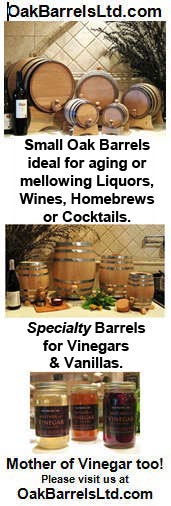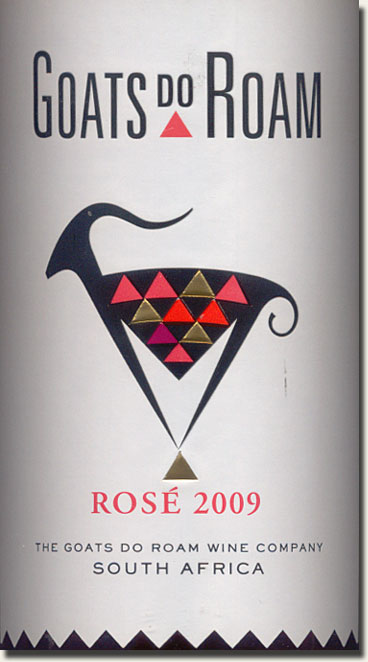3 from Goats Do Roam
Over the past several years, Goats do Roam has become arguably the most recognizable South African wine label in the US, not to mention the best-selling, as is the case with its Red Wine. So I was rather surprised to see their newly designed label, supposedly “inspired by an ancient Mesopotamian artefact,” and something of a departure from the previous version. It has a cleaner, more iconic look to it, but I can’t really say that I like it better. Fortunately, we’ve grown to know the wines pretty well, so our bottom line is what’s IN the bottle, not what’s on it, and happily, the latest versions of their red, white and rosé deliver pretty much the same solid QPR that we’ve come to expect from the brand.
We took a bottle of each to our friends Rod and Hayden Leon’s house, where they were enjoyed with freshly baked whole grain bread, roasted chicken and pot roast.
2009 Goats do Roam White, 54% Viognier, 40% Grenache Blanc, 6% Roussanne, 14% alc., $7.99-9.99: Clean, medium color with a slight tinge of peach; pleasant white peach and nectarine nose echoes and expand on the palate with some added apple and mineral undertones. Medium-to-medium-full bodied with good acids and length, and if it’s not terribly complex, it’s quite enjoyable for what’s here. From the Vineyard Brands tech sheet: The fruit for this wine is sourced from a number of vineyards in the Western Cape. Viognier is predominantly from vineyards on the slopes of Paarl mountain, grown on decomposed granite soils. Grenache Blanc is from vineyards in the Piekenierskloof mountains, near Citrusdal. Roussanne (Goats do Roam’s first harvest of this variety) is from a trellised vineyard in the Agter-Paarl. Most of the Viognier was whole bunch pressed, while the other varietals were destalked and lightly crushed. All wines were cold fermented in stainless steel tanks. After fermentation the individual components were left on their gross lees for three months prior to racking, blending and bottling for early enjoyment. Find this wine
2009 Goats do Roam Rosé, 50% Shiraz, 25% Mourvèdre, 15% Gamay Noir, 10% Grenache Noir, 13.78% alc., $7.99-9.99: Strawberry pink color, with ripe strawberry, raspberry and mineral flavors and aromas; one taster mentions cranberries and hints of orange peel. Medium-to-medium-full bodied, with zippy acids; the minerality plays off the fairly rich fruit nicely with nice intensity. Again, not terribly complex, but nice for what’s here. From the Vineyard Brands tech sheet: The grapes were harvested during the 2nd and 3rd week of February, from vineyards in the Paarl and Swartland regions. Most of the fruit is from trellised vineyards on Fairview with supplementary drip irrigation, planted on decomposed granite soils. The Swartland fruit is from unirrigated bushvines. The different varietals were harvested ripe and lightly crushed. The juice was drawn off the grapes (aside from the Gamay Noir) after 6 to 12 hours of skin contact depending on the varietal and colour extracted. Approximately 50 to 100 litres of juice per ton was drawn off and fermented separately. Gamay grapes were whole bunch pressed. All the juice was settled and cold fermented at 14°C. Find this wine
2008 Goats do Roam Red, 61% Shiraz, 14% Cinsault, 13% Mourvèdre, 8% Grenache, 4% Carignan, 14% alc., $7.99-9.99: Clean, dark color, with plum, black currant and blackberry flavors and aromas, shaded with a hint of smoke and earthy undertones; medium-full-to-full bodied, with acids that are more prominent than tannins in the structure. Very much in the Cotes du Rhône style, as one taster mentions leather, hints of cedar and an element of minerality. My only complaint is that the acidity is a little shrill at this point; it’s better with food now and a year or two in the cellar wouldn’t hurt at all. Rod, who normally sticks with whites, really likes this. From the Vineyard Brands tech sheet: The grapes were harvested in February 2008. Shiraz was harvested from trellised vineyards in Paarl, grown on decomposed granite soils. Cinsault was sourced from two older bush vine sites in Paarl and Agter-Paarl. Mourvèdre is primarily from dryland bush vines in the Swartland, on koffieklip soils. Grenache and Carignan were also from Swartland vineyards. All grapes were harvested fully ripe at between 24 and 26 degrees balling (brix). Grapes were destalked but not crushed and fermentation took place in stainless steel tanks using Rhône yeasts. After primary fermentation the wines were racked off and sent back to tanks for malolactic fermentation. This lasted two to three months. The wine is then lightly sulphured and sent to older barrels for approximately ten months. No new wood is used. Find this wine
Goats Do Roam imported byVineyards Brands, Inc., Birmingham, AL
Reporting from Day-twah,
geo t.






Thanks for the feedback, Bill; once again, we have ample evidence that great minds think alike!
I have to agree that the Goats Do Roam wines you reviewed are great in the taste per dollar department. They are easily a “house wine” for guests who are not wine enthusiasts. I can serve GDR wines, not be embarrassed by serving plonk to my “normal” friends, and yet still enjoy the wines. It’s a win-win choice.
RT @GoatsdoRoamWine @gangofpour sample the latest vintages of our Red, White and Rose. Glad to hear you liked the wines. http://ow.ly/1zeCb
Thanks! RT @GoatsdoRoamWine: @gangofpour sample the latest vintages .. Glad to hear you liked the wines. http://ow.ly/1zeCb @Vineyard_Brands
@gangofpour sample the latest vintages of our Red, White and Rose. Glad to hear you liked the wines. http://ow.ly/1zeCb
QPR All Stars from South Africa – http://bit.ly/dd1lNZ #wine